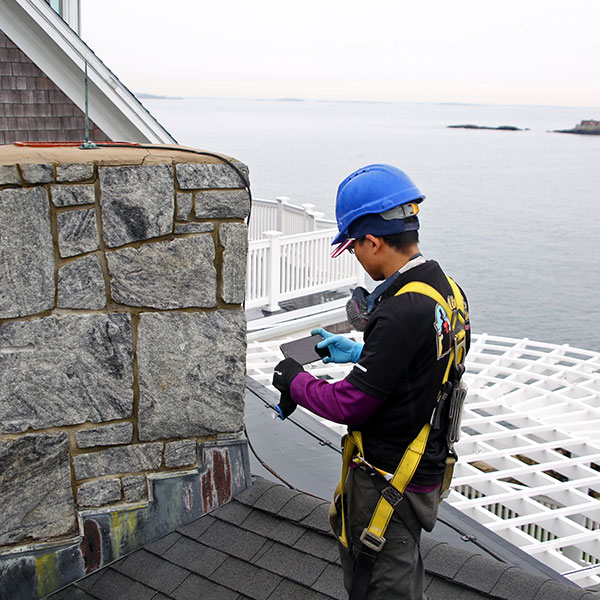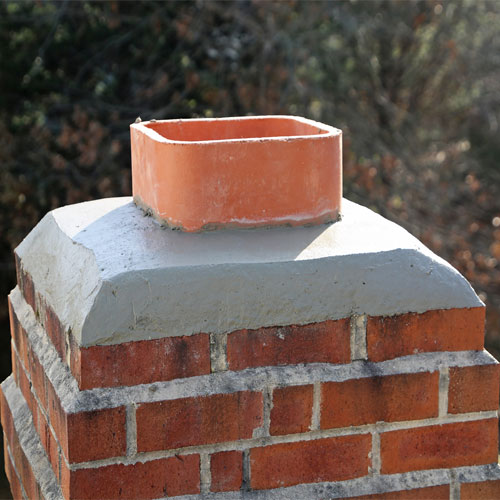Ahh! We have Chimney Leaks!
Are there water spots on the ceiling around your chimney or water dripping down the walls of the firebox? Water can cause hundreds of dollars of damage to the chimney and surrounding walls, flooring, and ceilings. If your chimney is leaking, call an expert right away! Chimney problems often compound over time. The longer you wait, the more you may have to repair.

There are many ways that water can get into the chimney. Rainwater may be running down an uncovered flue or seeping in through the masonry. Or, instead of precipitation, it may be condensation that isn’t able to evaporate.
Often, the source of the problem is tough to spot without years of training and experience. That’s why the best professional for the job is a certified chimney technician with years of experience diagnosing chimney problems and repairing leaks.
If you have a chimney leak, a professional chimney technician may recommend one of these six solutions.
6 Common Chimney Leak Solutions
#1. New chimney cap installation.
A chimney cap acts like an umbrella. It covers the top of the chimney and prevents water from running down the flue. If your chimney doesn’t have a cap, water, sleet, and snow can freely fall down the chimney.
If you notice water inside the fireplace, a missing or broken chimney cap may be the cause.
This is the most straightforward problem to diagnose and fix. You may even be able to see that the cap is missing when you look up at your chimney.
#2. New chimney liner.
Whenever you burn firewood, condensation is produced from moisture in the wood. The condensation should evaporate. If it doesn’t, it can seep into the chimney liner (if it’s tile) or run down the sides of the flue.
If you notice water in your fireplace and a missing chimney cap isn’t the problem, you may have a condensation problem. Your chimney liner may be the wrong size, or it may not be insulated well enough. Replacing the flue liner or insulating the flue should solve the problem.
#3. Flashing repairs or replacement.
Flashing bridges the gap between your roof and the chimney. If it’s broken or missing, precipitation can slip through the cracks and into your home.
Water damage showing up on walls, ceilings, and flooring around the chimney could be a sign that your chimney flashing is damaged.
Broken and damaged flashing can be hard to spot from the ground. When a chimney expert inspects your chimney, they will climb onto the roof to take a good look at the flashing and ensure it is intact. Even just a tiny piece of loose flashing can allow massive amounts of water to leak into your home.
#4. Waterproofing masonry.
Chimneys made of brick and mortar are especially vulnerable to water problems. Both bricks and mortar are porous. If they aren’t treated with a waterproofing sealant, they will absorb water much like a sponge. When water gets inside masonry, it can cause structural damage.
If you notice water damage where your chimney meets the wall or white discoloration (efflorescence) of the chimney bricks, the masonry may need to be waterproofed. A chimney expert can treat it with a waterproofing sealant that will prevent water from being absorbed while allowing condensation to escape. (If you decide to do it yourself, be sure you choose a sealant that’s designed for chimneys!)
 #5. Chimney crown repair or replacement.
#5. Chimney crown repair or replacement.
The chimney crown is a thick slab of concrete poured around the mouth of the chimney. Its role is to prevent rainwater, sleet, and melting snow from seeping into chimney bricks and mortar. If the crown is cracked or damaged, water may seep into the masonry weakening it.
The symptoms can look the same as #4. This is why a chimney technician performs a thorough inspection before diagnosing the cause of a chimney leak.
#6. Masonry repairs.
Broken bricks and cracked mortar are an easy pathway for water to get into masonry. Damaged masonry can be both a cause and symptom of water saturation.
You only notice the broken pieces of masonry or the same symptoms as #4 and 5. Tuck-point repairs to the masonry are the best solution to prevent more water from getting in. Repairing the broken masonry will also improve the structural integrity of your chimney.
Diagnosing the cause of a chimney leak can be tricky! It may be the result of more than one of these six problems or something else entirely. The only way to determine the exact cause is to call on a certified chimney technician trained in pinpointing the source of a chimney leak.
Stop the spread of water damage in it’s tracks by giving us a call! Set up an appointment for a professional chimney inspection today!
